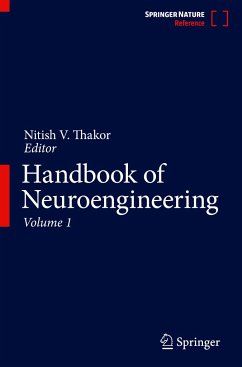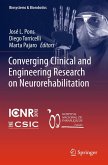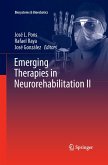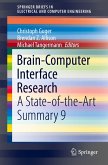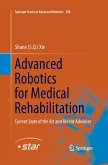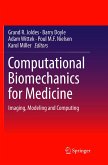Handbook of Neuroengineering
Herausgegeben:Thakor, Nitish V.
Handbook of Neuroengineering
Herausgegeben:Thakor, Nitish V.
- Gebundenes Buch
- Merkliste
- Auf die Merkliste
- Bewerten Bewerten
- Teilen
- Produkt teilen
- Produkterinnerung
- Produkterinnerung
This Handbook serves as an authoritative reference book in the field of Neuroengineering. Neuroengineering is a very exciting field that is rapidly getting established as core subject matter for research and education. The Neuroengineering field has also produced an impressive array of industry products and clinical applications. It also serves as a reference book for graduate students, research scholars and teachers. Selected sections or a compendium of chapters may be used as "reference book" for a one or two semester graduate course in Biomedical Engineering. Some academicians will…mehr
Andere Kunden interessierten sich auch für
![Converging Clinical and Engineering Research on Neurorehabilitation Converging Clinical and Engineering Research on Neurorehabilitation]() Converging Clinical and Engineering Research on Neurorehabilitation231,99 €
Converging Clinical and Engineering Research on Neurorehabilitation231,99 €![Emerging Therapies in Neurorehabilitation II Emerging Therapies in Neurorehabilitation II]() Emerging Therapies in Neurorehabilitation II75,99 €
Emerging Therapies in Neurorehabilitation II75,99 €![Brain-Computer Interface Research Brain-Computer Interface Research]() Brain-Computer Interface Research45,99 €
Brain-Computer Interface Research45,99 €![6th International Conference on Advancements of Medicine and Health Care through Technology; 17-20 October 2018, Cluj-Napoca, Romania 6th International Conference on Advancements of Medicine and Health Care through Technology; 17-20 October 2018, Cluj-Napoca, Romania]() 6th International Conference on Advancements of Medicine and Health Care through Technology; 17-20 October 2018, Cluj-Napoca, Romania112,99 €
6th International Conference on Advancements of Medicine and Health Care through Technology; 17-20 October 2018, Cluj-Napoca, Romania112,99 €![Advanced Robotics for Medical Rehabilitation Advanced Robotics for Medical Rehabilitation]() Shane Xie (S. Q.)Advanced Robotics for Medical Rehabilitation75,99 €
Shane Xie (S. Q.)Advanced Robotics for Medical Rehabilitation75,99 €![Emerging Therapies in Neurorehabilitation Emerging Therapies in Neurorehabilitation]() Emerging Therapies in Neurorehabilitation75,99 €
Emerging Therapies in Neurorehabilitation75,99 €![Computational Biomechanics for Medicine Computational Biomechanics for Medicine]() Computational Biomechanics for Medicine112,99 €
Computational Biomechanics for Medicine112,99 €-
-
-
This Handbook serves as an authoritative reference book in the field of Neuroengineering. Neuroengineering is a very exciting field that is rapidly getting established as core subject matter for research and education. The Neuroengineering field has also produced an impressive array of industry products and clinical applications. It also serves as a reference book for graduate students, research scholars and teachers. Selected sections or a compendium of chapters may be used as "reference book" for a one or two semester graduate course in Biomedical Engineering. Some academicians will construct a "textbook" out of selected sections or chapters. The Handbook is also meant as a state-of-the-art volume for researchers. Due to its comprehensive coverage, researchers in one field covered by a certain section of the Handbook would find other sections valuable sources of cross-reference for information and fertilization of interdisciplinary ideas. Industry researchers as well as clinicians using neurotechnologies will find the Handbook a single source for foundation and state-of-the-art applications in the field of Neuroengineering. Regulatory agencies, entrepreneurs, investors and legal experts can use the Handbook as a reference for their professional work as well.
Hinweis: Dieser Artikel kann nur an eine deutsche Lieferadresse ausgeliefert werden.
Hinweis: Dieser Artikel kann nur an eine deutsche Lieferadresse ausgeliefert werden.
Produktdetails
- Produktdetails
- Handbook of Neuroengineering
- Verlag: Springer / Springer Nature Singapore / Springer, Berlin
- Artikelnr. des Verlages: 978-981-16-5539-5
- 2023
- Seitenzahl: 3924
- Erscheinungstermin: 3. Februar 2023
- Englisch
- Abmessung: 241mm x 160mm x 217mm
- Gewicht: 7170g
- ISBN-13: 9789811655395
- ISBN-10: 9811655391
- Artikelnr.: 62264283
- Herstellerkennzeichnung
- Springer-Verlag GmbH
- Tiergartenstr. 17
- 69121 Heidelberg
- ProductSafety@springernature.com
- Handbook of Neuroengineering
- Verlag: Springer / Springer Nature Singapore / Springer, Berlin
- Artikelnr. des Verlages: 978-981-16-5539-5
- 2023
- Seitenzahl: 3924
- Erscheinungstermin: 3. Februar 2023
- Englisch
- Abmessung: 241mm x 160mm x 217mm
- Gewicht: 7170g
- ISBN-13: 9789811655395
- ISBN-10: 9811655391
- Artikelnr.: 62264283
- Herstellerkennzeichnung
- Springer-Verlag GmbH
- Tiergartenstr. 17
- 69121 Heidelberg
- ProductSafety@springernature.com
Nitish V. Thakor is the Director the Singapore Institute for Neurotechnology (SINAPSE) at the National University of Singapore, as well as Professor of Electrical and Computer Engineering and Biomedical Engineering at NUS. He maintains his position as a Professor of Biomedical Engineering, Electrical and Computer Engineering and Neurology at Johns Hopkins University in the USA. Dr. Thakor's technical expertise is in the field of Neuroengineering, including neural instrumentation, nuromorphic engineering, neural microsystems, optical imaging of the nervous system, neural control of prosthesis and brain machine interface and cognitive engineering. He has pioneered many technologies for brain monitoring to prosthetic arms and neuroprosthesis. He is an author of more than 290 refereed journal papers, more than a dozen patents, and co-founder of 3 companies. He is currently the Editor in Chief of Medical and Biological Engineering and Computing, and was the Editor in Chief of IEEE TNSRE from 2005-2011 and presently the EIC of Medical and Biological Engineering and Computing. Dr. Thakor is a recipient of a Research Career Development Award from the National Institutes of Health and a Presidential Young Investigator Award from the National Science Foundation, and is a Fellow of the American Institute of Medical and Biological Engineering, IEEE, Founding Fellow of the Biomedical Engineering Society, and Fellow of International Federation of Medical and Biological Engineering. He is a recipient of the award of Technical Excellence in Neuroengineering from IEEE Engineering in Medicine and Biology Society, Distinguished Alumnus Award from Indian Institute of Technology, Bombay, India, and a Centennial Medal from the University of Wisconsin School of Engineering. He has given more than 50 keynotes and plenary talks, and was the Chair of the IEEE Grand Challenges in Life Science Conference in 2013 and will chair IEEE BIOROB conference in Singapore in June 2016 and the Gordon Conference on Advanced Health Informatics in Hong Kong in July 2016¿.
Editorial / Excerps.- Subcellular Compartmentalization for Neurobiology: Focusing on the Axon.- Microfluidic Culture Platforms in Neuroscience Research.- Flexible and Soft Materials and Devices for Neural Interface.- Coatings for Microneural Implants: Biological and Mechanical Considerations.- Coatings for Microneural Implants: Electrical Considerations.- Quantitative Assessment of the Mechanical Properties of the Neural Interface.- Biomimetic Approaches Towards Device-Tissue Integration.- Implantable Device Fabrication and Packaging.- State-of-the-Art Technology on MEAs for Interfacing Live Neurons.- Distributed Neural Interfaces: Challenges and Trends in Scaling Implantable Technology.- Challenges for Large Scale Brain-Machine Interfaces.- Organic Bioelectronics.- High-Density Fiberless Optoelectrodes with Integrated Waveguides and miLEDs.- Nanostructured Platforms Interfacing with Nervous System.- Neuroflex: Intraneural and Extraneural Flexible Sensor Architectures for Neural Probing.- Regenerative Electrodes for Peripheral Nerve Interfacing.- Neurochemical Sensing.- Ultrasonic Wireless Neural Recording and Stimulation Interfaces.- Neural Drug Delivery.- Design Considerations for Implantable Neural Circuits and Systems.- Neuroprosthesis and Functional Electrical Stimulation (Peripheral).- Analogue Front-End Design for Neural Recording.- Implantable Direct Current Neural Modulation.- Energy-Efficient Electrical Stimulation Systems.- Wireless Bioelectronic Interfaces Electromagnetic Performance and Safety.- State-of-the-art technology on Highly Miniaturized Free-Floating Neural Implants.- Peripheral Neural Interfaces (PNIs) for Decoding Motor Intentions and Encoding Somatosensations in Upper-Limb Amputees.- Modeling Peripheral Nerve Stimulation.- Spinal Interfacing via Muscle Recordings for Neuroprosthesis Control.- Towards a wireless implantable brain-machine interface for locomotion control.- Visual Prostheses: Neuroengineering Handbook.- Vision: Optogenetics Addressing AMD Diseases.- Brain-Machine Interfaces for Upper and Lower Limb Prostheses.- Developing a Neuroprosthesis for Memory: The Past, Present, and Future.- Noninvasive and Invasive BCIs and Hardware and Software Components for BCIs.- Brain Co-processors: Using AI to Restore and Augment Brain Function.- Artificial Sensory Feedback to the Brain: Somatosensory Feedback for Neural Devices and BCI.- Brain-Computer Interface for Stroke Rehabilitation.- Brain-Machine Interfaces for Closed-Loop Electrical Brain Stimulation in Neuropsychiatric Disorders.- Brain-machine interfaces: from restoring sensorimotor control to augmenting cognition.- Motor BMIs Have Entered the Clinical Realm.- Neuromorphic Neural Interfaces.- Neuromorphic Circuits and Systems: From Neuron Models to Integrate-and-Fire Arrays.- Neuromorphic spiking neural network algorithms.- Programming Neuromorphics Using the Neural Engineering Framework.- Sensing-to-Learn and Learning-to-Sense: Principles for Designing NeuromorphicSensors.- Neuromorphic Tactile Sensing and Encoding.- Neuromorphic Sensing, Perception and Control for Robotics.- Emerging Technologies in Neuroengineering to Advance Rehabilitation, Improve Quality of Care Delivery, and Encourage Independent Living.- Neural Interfaces involving the CNS and PNS combined with upper limb actuators for motor rehabilitation after stroke: technical and clinical considerations.- Hybrid robotics and neuroprosthetics for associative neurorehabilitation.- Neuroprosthesis and Functional Electrical Stimulation (Peripheral).- Brain-Machine Interfaces for Neurorobotics.- Neurorehabilitation with Virtual and Augmented Reality Tools.- Content Augmentation in Virtual Reality with Cognitive-Conflict-Based Brain-Computer Interface.- Neuroengineering of the Upper Limb: Manipulation of the Peripheral and Central Nervous System to Improve Function.- Optimal and Adaptive Stimulation Design.- Mechanisms and Targeting of Deep-Brain Stimulation Therapies.- Noninvasive Electrical Brain Stimulation of the Central Nervous System.- Transcranial Ultrasound Stimulation.- Biophysics and Mechanisms of Spinal Cord Stimulation for Chronic Pain.- Modeling of the Peripheral Nerve to Investigate Advanced Neural Stimulation (Sensory Neural Prosthesis).- Closed-Loop Visceral Bioelectronics Therapies.- Models for Closed-Loop Cardiac Control Using Vagal Nerve Stimulation.- Sacral Nerve Stimulation for Gastrointestinal Disorders.- Sudden Deaths: A Failure of Feedback Control.- Electrical Block of Peripheral Nerves.- EEG Models and Analysis.- EEG-Based Machine Learning: Theory and Applications.- Neural Encoding and Decoding.- State Space Models for Spike Data.- Quantitative Modeling on Nonstationary Neural Spikes: From Reinforcement Learning to Point Process.- Real-Time Detection of Acute Pain Signals Based on Spikes/LFP.- Graph Theory for Brain Signal Processing.- Neuroscience of Cognitive Functions: From Theory to Applications.- Brain's Networks and Their Functional Significance in Cognition.- Cognitive State Analysis, Understanding, and Decoding from the Perspective of Brain Connectivity.- Vigilance Assessment and Enhancement.- Cognitive State Assessment and Monitoring: A Brain Connectivity Perspective.- Deep Learning Methods for EEG Neural Classification.- Consumer Neuroscience: A Neural Engineering Approach.- Multimodal Neuroimaging with Simultaneous fMRI and EEG.- Structural Neuroimaging: From Macroscopic to Microscopic Scales.- Shape Diffeomorphometry of Brain Structures in Neurodegeneration and Neurodevelopment.- Mapping Brain Networks Using Multimodal Data.- Multimodal and Multiparametric Neuroimaging of Gliomas.- Functional Monitoring and Imaging in Deep Brain Structures.- Optical Imaging of Epileptic Seizures.- Photoacoustic Imaging Tools for Neurological Applications.- Quantitative EEG Analysis in Intensive Care Patients.- Using Connectivity to Explain Neuropsychiatric Conditions: The Example of Autism.- Determining the Role of Synchrony Dynamics in Epileptic Brain Networks.- Computational Approaches for Diagnosis and Monitoring of Epilepsy from Scalp EEG.- Somatosensory neuromodulation with a focus towards clinical systems.- A Neuroprosthetic for Individuals with Tetraplegia: The path from a clinical research tool to a home-use assistive device.- Towards Real-World Neuromonitoring and Applications in Cognitive Engineering.- The 2020 Roadmap for Bioelectronic Medicine.- Neurotechnology: Patenting Roadmap.- Quality Management Systems for Neural Engineering: Principles and Practices.- Invasive Neural Integration and Clinical Translation.- Neurosurgical Considerations for the Brain Computer Interface.- Developing ethical guidelines for implantable neurotechnology: The importance of incorporating stakeholder input.
Editorial / Excerps.- Subcellular Compartmentalization for Neurobiology: Focusing on the Axon.- Microfluidic Culture Platforms in Neuroscience Research.- Flexible and Soft Materials and Devices for Neural Interface.- Coatings for Microneural Implants: Biological and Mechanical Considerations.- Coatings for Microneural Implants: Electrical Considerations.- Quantitative Assessment of the Mechanical Properties of the Neural Interface.- Biomimetic Approaches Towards Device-Tissue Integration.- Implantable Device Fabrication and Packaging.- State-of-the-Art Technology on MEAs for Interfacing Live Neurons.- Distributed Neural Interfaces: Challenges and Trends in Scaling Implantable Technology.- Challenges for Large Scale Brain-Machine Interfaces.- Organic Bioelectronics.- High-Density Fiberless Optoelectrodes with Integrated Waveguides and miLEDs.- Nanostructured Platforms Interfacing with Nervous System.- Neuroflex: Intraneural and Extraneural Flexible Sensor Architectures for Neural Probing.- Regenerative Electrodes for Peripheral Nerve Interfacing.- Neurochemical Sensing.- Ultrasonic Wireless Neural Recording and Stimulation Interfaces.- Neural Drug Delivery.- Design Considerations for Implantable Neural Circuits and Systems.- Neuroprosthesis and Functional Electrical Stimulation (Peripheral).- Analogue Front-End Design for Neural Recording.- Implantable Direct Current Neural Modulation.- Energy-Efficient Electrical Stimulation Systems.- Wireless Bioelectronic Interfaces Electromagnetic Performance and Safety.- State-of-the-art technology on Highly Miniaturized Free-Floating Neural Implants.- Peripheral Neural Interfaces (PNIs) for Decoding Motor Intentions and Encoding Somatosensations in Upper-Limb Amputees.- Modeling Peripheral Nerve Stimulation.- Spinal Interfacing via Muscle Recordings for Neuroprosthesis Control.- Towards a wireless implantable brain-machine interface for locomotion control.- Visual Prostheses: Neuroengineering Handbook.- Vision: Optogenetics Addressing AMD Diseases.- Brain-Machine Interfaces for Upper and Lower Limb Prostheses.- Developing a Neuroprosthesis for Memory: The Past, Present, and Future.- Noninvasive and Invasive BCIs and Hardware and Software Components for BCIs.- Brain Co-processors: Using AI to Restore and Augment Brain Function.- Artificial Sensory Feedback to the Brain: Somatosensory Feedback for Neural Devices and BCI.- Brain-Computer Interface for Stroke Rehabilitation.- Brain-Machine Interfaces for Closed-Loop Electrical Brain Stimulation in Neuropsychiatric Disorders.- Brain-machine interfaces: from restoring sensorimotor control to augmenting cognition.- Motor BMIs Have Entered the Clinical Realm.- Neuromorphic Neural Interfaces.- Neuromorphic Circuits and Systems: From Neuron Models to Integrate-and-Fire Arrays.- Neuromorphic spiking neural network algorithms.- Programming Neuromorphics Using the Neural Engineering Framework.- Sensing-to-Learn and Learning-to-Sense: Principles for Designing NeuromorphicSensors.- Neuromorphic Tactile Sensing and Encoding.- Neuromorphic Sensing, Perception and Control for Robotics.- Emerging Technologies in Neuroengineering to Advance Rehabilitation, Improve Quality of Care Delivery, and Encourage Independent Living.- Neural Interfaces involving the CNS and PNS combined with upper limb actuators for motor rehabilitation after stroke: technical and clinical considerations.- Hybrid robotics and neuroprosthetics for associative neurorehabilitation.- Neuroprosthesis and Functional Electrical Stimulation (Peripheral).- Brain-Machine Interfaces for Neurorobotics.- Neurorehabilitation with Virtual and Augmented Reality Tools.- Content Augmentation in Virtual Reality with Cognitive-Conflict-Based Brain-Computer Interface.- Neuroengineering of the Upper Limb: Manipulation of the Peripheral and Central Nervous System to Improve Function.- Optimal and Adaptive Stimulation Design.- Mechanisms and Targeting of Deep-Brain Stimulation Therapies.- Noninvasive Electrical Brain Stimulation of the Central Nervous System.- Transcranial Ultrasound Stimulation.- Biophysics and Mechanisms of Spinal Cord Stimulation for Chronic Pain.- Modeling of the Peripheral Nerve to Investigate Advanced Neural Stimulation (Sensory Neural Prosthesis).- Closed-Loop Visceral Bioelectronics Therapies.- Models for Closed-Loop Cardiac Control Using Vagal Nerve Stimulation.- Sacral Nerve Stimulation for Gastrointestinal Disorders.- Sudden Deaths: A Failure of Feedback Control.- Electrical Block of Peripheral Nerves.- EEG Models and Analysis.- EEG-Based Machine Learning: Theory and Applications.- Neural Encoding and Decoding.- State Space Models for Spike Data.- Quantitative Modeling on Nonstationary Neural Spikes: From Reinforcement Learning to Point Process.- Real-Time Detection of Acute Pain Signals Based on Spikes/LFP.- Graph Theory for Brain Signal Processing.- Neuroscience of Cognitive Functions: From Theory to Applications.- Brain's Networks and Their Functional Significance in Cognition.- Cognitive State Analysis, Understanding, and Decoding from the Perspective of Brain Connectivity.- Vigilance Assessment and Enhancement.- Cognitive State Assessment and Monitoring: A Brain Connectivity Perspective.- Deep Learning Methods for EEG Neural Classification.- Consumer Neuroscience: A Neural Engineering Approach.- Multimodal Neuroimaging with Simultaneous fMRI and EEG.- Structural Neuroimaging: From Macroscopic to Microscopic Scales.- Shape Diffeomorphometry of Brain Structures in Neurodegeneration and Neurodevelopment.- Mapping Brain Networks Using Multimodal Data.- Multimodal and Multiparametric Neuroimaging of Gliomas.- Functional Monitoring and Imaging in Deep Brain Structures.- Optical Imaging of Epileptic Seizures.- Photoacoustic Imaging Tools for Neurological Applications.- Quantitative EEG Analysis in Intensive Care Patients.- Using Connectivity to Explain Neuropsychiatric Conditions: The Example of Autism.- Determining the Role of Synchrony Dynamics in Epileptic Brain Networks.- Computational Approaches for Diagnosis and Monitoring of Epilepsy from Scalp EEG.- Somatosensory neuromodulation with a focus towards clinical systems.- A Neuroprosthetic for Individuals with Tetraplegia: The path from a clinical research tool to a home-use assistive device.- Towards Real-World Neuromonitoring and Applications in Cognitive Engineering.- The 2020 Roadmap for Bioelectronic Medicine.- Neurotechnology: Patenting Roadmap.- Quality Management Systems for Neural Engineering: Principles and Practices.- Invasive Neural Integration and Clinical Translation.- Neurosurgical Considerations for the Brain Computer Interface.- Developing ethical guidelines for implantable neurotechnology: The importance of incorporating stakeholder input.

